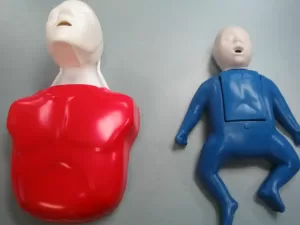Candidates frequently ask the question of what the difference between infant CPR and child CPR is. It is important to have a definition of what an infant is in the world of CPR. Infants are under the age of 1. Infants are more fragile, the bones are not as developed, and are significantly smaller than most children. Because of the previously mentioned difference, CPR for infants is different. This page will describe the 6 major differences between infant CPR and child CPR. The material posted on this page is for information purposes only and if you would like to learn infant or child CPR, take a CPR course with a credible provider.
The 6 Major Differences in CPR between an Adult / Child and an Infant:
- Rescuers must ask for permission before approaching and helping an infant. This may hold true for children in most parts of Canada, however, Candidates MUST ask for permission prior to helping an infant. If no parents or caregivers are present to give consent then the rescuer may continue as consent is implied.
- When checking for responsiveness candidates should tickle or “wiggle” the feet of an infant instead of tapping the shoulders. This is a more effective way of checking for responsiveness for an infant.
- Candidates may ask for an AED when sending a bystander to contact EMS, however, candidates can only apply pediatric AED pads for an infant. Candidates should not place adult or child AED pads on an infant.
-
The picture shows the two different training mannequins. The smaller one is for infant CPR. The larger is for adult and child CPR. When opening the airway for an infant, the rescuer must be careful not to have the head tilted too little or too much. The airway of an infant can be compared to a straw. If the straw is pulled too far back or too close together air will have a difficult time passing through. This can also be applied to how the airway of an infant works. Candidates need to place the airway of an infant into the “sniffing position” which is the position in which the infant’s chin and nose are parallel to the ground.
- When ventilating (giving breaths), candidates need to be careful to give only a small amount of air or a “puff” of air. When candidates ask how much air to give an infant the general answer is: enough to blow out a single candle in front of your mouth. The infant’s lungs are significantly smaller and too much air can be detrimental to the health of the infant.
- When applying chest compressions to a infant candidates need to landmark approximately one inch below the area that is between the nipples. Candidates must also do chest compressions with two fingers instead of the whole hand. The infant’s chest is significantly smaller and using a whole hand or two hands for compression will cause significant internal damage to the infant.
These are the 6 major differences between adult/child CPR and infant CPR. For more information or to learn how to do CPR on an infant, adult or child take a workplace-approved CPR or first aid course near you.

